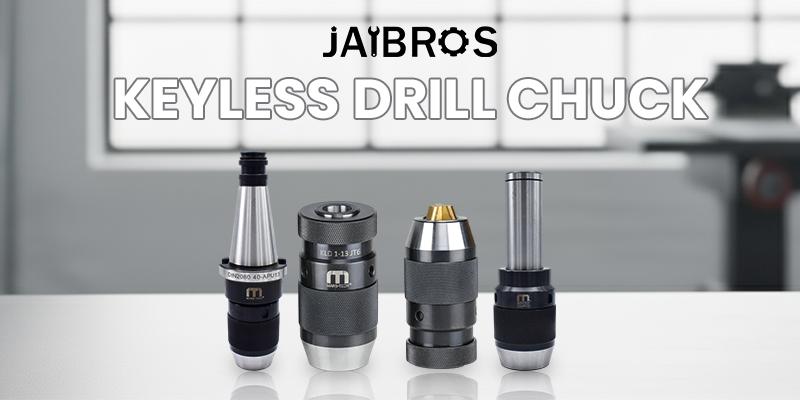A Beginner’s Guide to Understanding Drill Chuck Types

Explore the different drill chuck types, how they work, and which one suits your drilling needs. A simple, beginner-friendly guide to help you make the right choice.
Top Drill Chucks for Precision Drilling and Smooth Performance
You can’t drill without a sharp bit and steady hands, but for precision drilling nothing more is helpful than the right kind of drill chuck. Whether you are a professional machinist, weekend Do-It-Yourselfer, or running the production line, the right drill chuck will enhance your ability to produce an accurate hole, reduce vibration and extend the life of your tool bits and equipment. This guide will lead you through the things that we feel make a great chuck, common types, top picks in various categories for different needs and how to assess (drill) chuck price along with real-world tips to get the smoothest performance from your drill machine chuck.
What is a drill chuck and why it matters
A drill chuck is the clamping mechanism that holds drill bits and other rotary tooling on a drill or drill press. It’s the unsung hero between the motor and the cutting edge — and a poor chuck can ruin an otherwise excellent tool setup. The chuck determines runout (how much the bit wobbles), gripping strength, ease of bit changes, and compatibility with different shank sizes. For precision drilling, minimizing runout and ensuring secure grip are the most important features.
Types of drill chucks
Understanding the types of chucks helps you pick the best one for your application.
Keyed drill chucks
Keyed chucks use a toothed key to tighten and loosen the jaws. They typically provide stronger clamping force, which is helpful for heavy-duty drilling and larger bits. Keyed chucks are common on drill presses and industrial machines.
Keyless drill chuck
A keyless drill chuck allows you to hand-tighten or release the bit, typically with a fast twist. They are particularly useful when bit changes need to happen often and are usually found on cordless drills. Although convenient, older, or less expensive keyless chucks may provide less clamping torque (or grip) and slightly higher runout when compared to high-end keyed chucks.
Jacobs taper and Morse taper fittings
Some drill chucks attach to the drill spindle using tapers (for example, Jacobs taper or Morse taper) for a secure, concentric fit that minimizes runout. This kind is seen on drill presses and lathes. If precision is more important, chucks with taper fitting could be a suitable option.
Industrial collet chucks
Collet chucks use a collet to grasp the shank, and are generally used where the best concentricity is needed. They are effective for tooling with small diameters, and for applications with high speeds.
Key features to look for in a drill chuck
Choosing the right chuck means balancing convenience, accuracy, and durability. Focus on these features:
Runout (concentricity)
Low runout is crucial for precision. Even a few thousandths of an inch can affect hole quality and bit life. Look for chucks with published runout specifications if you need high precision.
Jaw construction and material
Hardened steel jaws and body resist wear and maintain clamping accuracy over time. Avoid cheap chucks with softer metals that deform or wear quickly.
Compatibility and capacity
Check the chuck’s capacity (e.g., 0.3–13 mm or 1/32"–1/2") and mounting style — whether it’s designed for your cordless drill, bench drill, or a spindle with a taper. A universal fit saves hassle.
Clamping force and torque
Stronger clamping force reduces slippage during heavy cuts. Keyed chucks and higher-quality keyless models with robust internal mechanisms provide better torque transfer.
Ease of bit change
If you change bits often, a keyless drill chuck provides speed and convenience. For stationary setups or heavy drilling, a keyed chuck’s power may be preferable.
Corrosion resistance and maintenance needs
Quality chucks come with rust-resistant finishes or coatings. Easy disassembly for cleaning and lubrication extends lifetime and keeps runout low.
Top drill chuck picks for precision drilling and smooth performance
Below are recommended types and features rather than specific promotional brands, so you can match features to your needs.
Precision bench drill chuck (for drill presses)
Choose a hardened-steel chuck with taper mounting and advertised low runout. These are designed for repeatable, precise holes and long service life. They pair well with high-quality drill press spindles.
High-torque keyed chuck (for heavy-duty work)
If you drill large holes or use demanding materials, a high-torque keyed chuck with hardened jaws and robust gearing provides reliable grip and prevents slippage under load.
High-quality keyless drill chuck (for frequent bit changes)
Modern, premium keyless drill chucks have improved internal mechanisms that rival keyed chucks in clamping force while offering the convenience of tool-free bit swaps. Look for models with ratcheting or self-tightening designs and precise machining.
Taper-mount chuck (for lathes and precision machines)
A chuck with a Jacobs or Morse taper gives superior concentricity when mounted correctly. This is ideal for machinists who need precision and repeatable alignment on drill presses and lathes.
Collet chuck (for microlocation and small-diameter tools)
For minimal runout in small-diameter tooling, collet systems are the gold standard. Combine a collet chuck with a precise spindle and sharp tooling for the best results in micro-drilling.
Drill chuck price: balancing cost and performance
When evaluating drill chuck price, remember that you’re paying for materials, precision machining, and long-term performance. Low-priced chucks may be tempting but can introduce runout, wear quickly, and increase operating costs by ruining bits and generating rework.
A rough guide:
-
Entry-level chucks (basic keyless models): budget-friendly but variable quality; best for casual DIY.
-
Mid-range chucks (better keyless and basic keyed): good for regular hobbyist and light professional use.
-
Premium chucks (precision bench, tapered mount, hardened jaws): higher initial drill chuck price, but excellent long-term value for production and precision work.
Compare warranty coverage, available specifications (runout data), and user reviews. For professional or high-precision tasks, investing in a higher-quality chuck typically pays back in fewer rejected parts and longer tool life.
How to install and set up your drill machine chuck for best accuracy
Correct installation dramatically affects performance.
Clean mating surfaces
Remove dirt, burrs, and old grease from tapers and spindle faces before mounting. Even small debris can cause runout.
Follow mounting torque specs
Whether tightening a keyed chuck on a spindle or aligning a taper-mounted chuck, use the manufacturer’s torque recommendations to avoid damaging threads or causing misalignment.
Test runout after mounting
Use a dial indicator to check runout, and re-seat the chuck if the runout exceeds acceptable limits. Small adjustments can yield big improvements in hole quality.
Use the right adapter or arbor
If your chuck requires an arbor or adapter, ensure it is machined and balanced to avoid introducing eccentricity.
Maintenance tips for long life and continued precision
Routine care keeps performance consistent.
Regular cleaning and lubrication
Disassemble and clean the jaws and internal mechanism periodically. Light machine oil or a specified lubricant will keep moving parts smooth. Avoid over-lubricating jaws that grip the bit directly.
Inspect for wear
Check jaws and teeth for rounding or uneven wear. Replace the chuck or parts when wear affects grip or concentricity.
Keep keys and spindles in good condition
For keyed chucks, maintain the chuck key and pinions. Worn gear teeth reduce torque transfer and can cause slippage.
Store properly
When not in use, keep chucks in a dry, dust-free area. A quick wipe with a rust inhibitor before storage helps prevent corrosion.
Practical drilling tips to improve precision and smooth performance
Small technique changes amplify chuck quality.
Use sharp, appropriate bits
A precise chuck can't fix a dull or bent bit. Match bit type to material and keep cutting edges sharp.
Use correct speeds and feeds
High RPMs with improper feed rates amplify runout effects and increase chatter. Use recommended spindle speeds for the bit diameter and material.
Start with a pilot hole
For large-diameter holes, drilling a smaller pilot hole reduces side-loading and bit flex, resulting in cleaner holes.
Clamp your work securely
Vibration from loose workpieces transfers to the bit and chuck. Solid clamping reduces runout effects and improves finish.
Safety considerations
Chucks are mechanical devices under load. Follow these safety tips:
-
Always unplug or remove power before changing bits.
-
Use the correct chuck key and remove it before starting the drill.
-
Wear eye protection to guard against flying chips.
-
Keep loose clothing and long hair away from rotating parts.
Choosing between keyed and keyless: which is right for you?
Keyed and keyless systems each have their strengths:
-
Choose a keyed chuck when you need maximum clamping force for heavy-duty drilling and larger bits.
-
Choose a keyless drill chuck for convenience when you change bits frequently or work with cordless drills and light-to-medium drilling tasks.
-
For bench or industrial setups where precision is crucial, prioritize runout specs and mounting style (taper vs. threaded spindle) over whether the chuck is keyed or keyless.
Final checklist before you buy
Before purchasing a chuck, verify:
-
Compatibility with your drill machine chuck mount (thread or taper).
-
Capacity covers the bit sizes you use.
-
Runout or concentricity specifications if you need precision.
-
Material and construction (hardened steel, finish).
-
Warranty and availability of replacement parts.
-
How drill chuck price fits into your maintenance and tooling budget.
Company bio
Jaibros.com is an Indian website dedicated to quality CNC tools, drills, milling tools, turning tools and some precision machining accessories. Their focus is on professionalism, precision, and efficiency. Jaibros provides verified, reliable, and durable tools from trusted manufacturers, often coupled with the technical support of experts. The site carries drill machine chucks, collets, indexable tooling, inserts, and other tools and accessories for both hobbies and industrial purposes. Authentically sourced products with fast shipping and responsive customer service provide workshops and manufacturers with the tools to be more efficient with their work and less downtime.
Conclusion
Choosing the appropriate chuck is a true investment in precision, safety and long term efficiency. Whether it's a rugged keyed chuck for heavy cutting, or a more modern keyless drill chuck for quick bit changes, or a taper-mounted precision chuck for the greatest concentricity, consider qualities such as runout, jaw quality and style of mounting beforehand. Also realize the order a drill chuck should be part of what you're willing to pay per expected lifetime - sometimes paying a little more to get a little higher quality drill chuck saves money in broken bits, rework and machine downtime. With an appropriate chuck system, installed carefully and with maintenance, you have drilling more smoothly, accurately and dependably.






